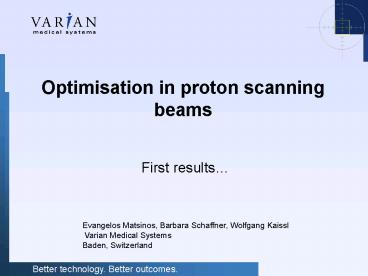Optimisation in proton scanning beams - PowerPoint PPT Presentation
1 / 21
Title:
Optimisation in proton scanning beams
Description:
Evangelos Matsinos, Barbara Schaffner, Wolfgang Kaissl. Varian Medical Systems ... Beam beamlets or pencil beams (defined by the resolution of the calculation grid) ... – PowerPoint PPT presentation
Number of Views:61
Avg rating:3.0/5.0
Title: Optimisation in proton scanning beams
1
Optimisation in proton scanning beams
- First results
2
Basic steps
- Calculation of the dose-deposition coefficients
(ddcs) - Optimisation of the spot weights
3
(No Transcript)
4
Spots and beamlets
- Beam ? beamlets or pencil beams (defined by the
resolution of the calculation grid) - The dose from each beamlet is evaluated (at the
vertices of the calculation grid) - The spot dose is calculated (as the sum of the
dose contributions of the corresponding beamlets,
weighted for the position of each beamlet within
the spot)
5
spot
Sx and Sy depend on z
? depends on the density and on z
beamlet
6
Optimisation a closer look
- Desired dose at point i pi
- Dose delivered at point i di ? aij xj
(sum over all sources j)
Objective function Fobj ? (di - pi)2
(sum over target points)
contribution due to the violation of dose-limit
constraints (for targets and organs)
contribution due to the violation of
dose-volume constraints (for organs)
7
Optimisation methods
- Conjugate Gradient (CG)
- Simulated Annealing (SA)
- Simultaneous optimisation (PSI)
- Generalised Sampled Pattern Matching (GSPM)
- ( under development)
8
Strategy in the optimisation
- Pre-optimisation
- ? Reasonable initial guess for the weights
- ? Convergence ? two consecutive iterations
- yield improvement below 5
- Main optimisation
- ? Full implementation of a method
- ? Convergence ? two consecutive iterations
- yield improvement below 0.1
9
Toy example
- A phantom has been created with three important
structures one target and two organs some
inhomogeneity has been introduced (an additional
structure simulating the presence of a bone) - Pixel size 2.5mm
- Spot advance in y (scanning direction) 2.5mm
- Spot advance in x 5mm
- Cut-off for dose contributions 3 standard
deviations
10
Target 2,412 points, 57.27 cm3 Distal Organ
2,166 points, 48.34 cm3 Proximal Organ 683
points, 15.49 cm3 Number of points 5,261
11
Number of parameters 4,798
12
ProtonHelios
13
Dose-Volume Histograms
Prescription dose 50 Gy (? 2)
Organ constraints 25 Gy in 10 of the distal
organ15 Gy in the proximal organ
14
Dose distribution (exclusive fit to the target)
15
Dose distribution (fit to all structures)
16
Comparison of a few numbers
17
Weight distribution
PSI method
18
Weight distribution
SA method
19
A head tumour
20
Conclusions
- As far as the dose distribution is concerned,
three optimisation methods (CG, SA, and PSI)
yield results which seem to be in good agreement.
Very similar dose distributions may be obtained
on the basis of very different weight
distributions. - The use of raw (unfiltered) weights does not seem
to create cold/hot spots within the irradiated
volume. It remains to be seen whether, in some
occasions, filtering will be called for.
21
Under consideration
- Other forms of the objective function to be
tried? - Strategy in the optimisation an improvement of
about 25 was found in the execution time in case
that the target dose is firstly optimised (with
vanishing dose everywhere else) - Other optimisation methods to be tried?































